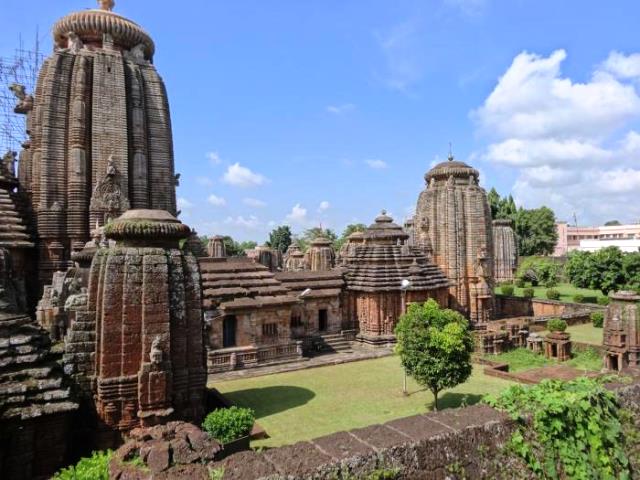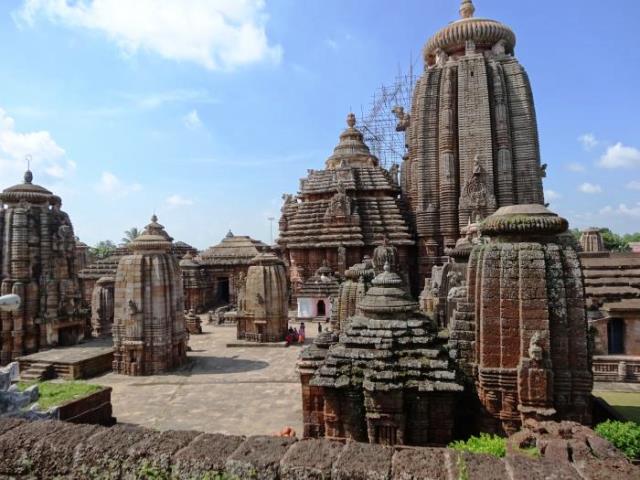Lingaraja Temple Odisha
About Lingaraja Temple
Lingaraj Temple is a Hindu temple dedicated to Harihara, a form of Shiva and Vishnu and is one of the oldest temples in Bhubaneswar, the capital of the East Indian state of Orissa. The temple is the most prominent landmark of the Bhubaneswar city and one of the major tourist attractions of the state.
The Lingaraja temple is the largest temple in Bhubaneswar. The central tower of the temple is 180 ft (55 m) tall. The temple represents the quintessence of the Kalinga Architecture and culminating the medieval stages of the architectural tradition at Bhubaneswar. The temple is believed to be built by the kings of the Somavamsi dynasty, with later additions from the Ganga rulers. The temple is built in the Deula style that has four components namely, vimana ( a structure containing the sanctum), jagamohana (assembly hall), natamandira (festival hall) and bhoga-mandapa (hall of offerings), each increasing in the height to its predecessor. The temple complex has 50 other shrines and is enclosed by a large compound wall.
Bhubaneswar is called the Ekamra Kshetra as the deity of Lingaraj was originally under a mango tree (Ekamra) as noted in Ekamra Purana, a 13th-century Sanskrit treatise. The temple is active in worship practises, unlike most other temples in Bhubaneswar and Shiva is worshipped as Harihara, a combined form of Vishnu and Shiva. The temple has images of Vishnu, possibly because of the rising prominence of Jagannath sect emanating from the Ganga rulers who built the Jagannath Temple in Puri in the 12th century.
Lingaraja temple is maintained by the Temple Trust Board and the Archaeological Survey of India (ASI). The temple has an average of 6,000 visitors per day and receives lakhs of visitors during festivals. Shivaratri festival is the major festival celebrated in the temple and event during 2012 witnessed 200,000 visitors. Lingaraj, literally means the king of Lingam, the iconic form or Shiva. Shiva was originally worshipped as Kirtivasa and later as Harihara and is commonly referred as Tribhuvaneshwara (also called Bhubaneswar), the master of three worlds, namely, heaven, earth and netherworld. His consort is called Bhuvaneshvari.
The temple in its present form dates back to the last decade of the eleventh century. There is evidence that part of the temple was built during the sixth century CE as mentioned in some of the seventh centuries Sanskrit texts. Fergusson believes that the temple might have been initiated by Lalat Indu Keshari who reigned from 615 to 657 CE. The Assembly hall (jagamohana), sanctum and temple tower were built during the eleventh century, while the Hall of offering (bhoga-mandapa) was built during the twelfth century. The natamandira was built by the wife of Salini between 1099 and 1104 CE. By the time the Lingaraj temple was completely constructed, the Jagannath ( a form of Vishnu) sect had been growing in the region, which historians believe, is evidenced by the co-existence of Vishnu and Shiva worship at the temple. The kings of Ganga dynasty were ardent followers of Vaishnavism and built the Jagannath Temple at Puri in the 12th century.
As per some accounts, the temple is believed to have been built by the Somavanshi king Yayati I (1025-1040), during the 11th century CE. Jajati Keshari shifted his capital from Jajpur to Bhubaneswar which was referred to as Ekamra Kshetra in the Brahma Purana, an ancient scripture. One of the Somavamsi queens donated a village to the temple and the Brahmins attached to the temple received generous grants. An inscription from the Saka year 1094 (1172 CE) indicates gifts of gold coins to the temple by Rajaraja II. Another inscription of Narasimha I from the 11th century indicates the offer of beetel leaves as tambula to the presiding deity. Other stone inscriptions in the temple indicate royal grants from Chodaganga to the nearby village people.
K.C. Panigrahi mentions that Yayti I had no time to build the temple and it should have been initiated by his sons Ananta Kesari and Udyota Kesari (believed to be other names of Yayati II as well). The argument provided against the view is that is his weak successors could not have constructed such a magnificent structure.
Bhubaneswar is called the Ekamra Kshetra as the deity of Lingaraj was originally under a mango tree (Ekamra). Ekamra Purana, a Sanskrit treatise of the 13th century mentions that the presiding deity was not seen as lingam (an aniconic form of Shiva) during the Satya and Treta yugas and only during the Dwapara and Kali Yuga yugas, it emerged as a lingam. The lingam in the temple is a natural unshaped stone that rests on a Sakti. Such a lingam is called Krutibasa or Swayambhu and is found in 64 places in different parts of India. With the advent of the Ganga dynasty in the early 12th century, who had Vaishnavaite orientation, a new movement started resulting in the synthesis of Saivism and Vaishnavism. The Ekamra was associated with Vaishanavite gods Krishna and Balaram during the period.
It is attributed the raising prominence of Jagannath sect that became predominant during the construction of the temple. The Gangas remodelled the temple and introduced certain Vaishnavite elements like images of Vaishnava Dwarapalas namely Jaya and Prachanda, Jagannatha, Lakshmi Narayan and Garuda were installed. Tulsi leaves, which are favoured by Vishnu, was used along with Bela leaves for the worship of Lingaraj. Lingaraja was thus came to be known as Harihara, a combination of Shiva and Vishnu. The flag of the temple was fixed to a Pinaka bow instead of trident usually found in Shiva temples. The temple priests also changed the mark in their forehead from horizontal to a "U" sign with a dotted middle line. The Gangas also introduced certain fairs like Swing festival, Sun worship and mock quarrel between priests after chariot festival, similar to the practises in Jagannath Temple in Puri. The influence of the Ganga dynasty has led to a cosmopolitan culture, that has reduced the status of Lingaraja temple as a distinct Saivite shrine. As per Hindu legend, an underground river originating from the Lingaraj temple fills the Bindusagar Tank (meaning ocean drop) and the water is believed to heal physical and spiritual illness. The water from the tank is thus treated sacred and pilgrims take a holy dip during festive occasions. The central deity of the temple, Lingaraj, is worshipped both as Shiva and Vishnu. The harmony between the two sects of Hinduism, Saivism and Vaishanvism, is seen in this temple where the deity is worshipped as Harihara, a combined form of Vishnu and Shiva
Shivaratri is the main festival celebrated annually in Phalgun month when thousands of devotees visit the temple. Apart from a full day of fasting, bel leaves are offered to Lingaraj on this auspicious day. The main celebrations take place at night when devotees pray all night long. The devout usually break their fast after the Mahadipa (a huge lamp) is lit on the spire of the temple. This festival commemorates Lingaraj having slayed a demon. Thousands of bol bom pilgrims carry water from river Mahanadi and walk all the way to the temple during the month of Shravana every year. Sunian day is observed from royal times in the month of Bhandra, a day when temple servants, peasants and other holders of temple lands offer loyalty and tribute to Lingaraja. Candan Yatra (Sandalwood ceremony) is a 22-day festival celebrated in the temple when servants of the temple disport themselves in a specially made barge in Bindusagar tank. The deities and servants of the temples are anointed with sandalwood paste to protect from heat. Dances, communal feasts and merrymaking are arranged by the people associated with the temple.
Every year the chariot festival (Ratha-Yatra) of Lingaraja is celebrated on Ashokashtami. The deity is taken in a chariot to Rameshwar Deula temple. Thousands of devotees follow and pull brightly decorated chariots containing the idols of Lingaraj and his sister Rukmani.
The Lingaraja temple is active in worship practises, unlike the other ancient temples of Bhubaneshwar which are not active worship centres. Non Hindus are not allowed inside the temple, but it can be viewed from the viewing platform located outside the temple. The viewing platform and the back of the temple can be reached via a lineway located to the right of the main entrance of the temple. Sanctity of the temple is maitained by disallowing dogs, unbathed visitors, mensturating women and families that encountered birth or death in the preceding 12 days. In case of a foreign trespass, the temple follows a purification ritual and dumping of prasad (food offering) in a well.
By Air: Regular flights landing at the only major airport of the city namely Biju Patnaik Airport connect it to all the major cities of the country such as Calcutta, Delhi, Chennai, Mumbai, Vishakhapatnam, Hyderabad and Raipur.
By Rail: There is a good train network also that connects Calcutta, Puri, Madras, Delhi, Bombay, Bangalore, Guwahati, Hyderabad, Tirupati and Trivandrum to Bhubaneswar by express and super express trains plying to and fro on a daily basis.
By Road: Odisha (Orissa) is well connected to its neighbouring states through a good road network.
- OTDC resorts & hotels.
- Swosti palm resort.
- Panthanivas puri.
- Konark sun temple.
- Chilika Lake.
- Jagannath temple.
- Nandankaran zoological park.
- Dhauli.
- Rajarani temple.
- Simipal National Park.
.
A total of 22 worship services is offered on a daily basis.
The idol of Lingaraja once in a year is taken to the Jalamadir that is built at the centre of the Bindu Sagar Lake.
At 6:30 A.M. the temple door is opened and a servant named Akhanda lights the lamp to awaken the Lord from his sleep. This is followed by the ablution and the arati. The priest announces that this is done in the name of the Raja of Puri.
The ritual of ‘Mahasnana’ or bathing the deity with water is completed which is followed by the pouring of ‘Panchamrita’.
Between 1 p.m. and 1:30 p.m, the food offering or ‘Ballabha Bhoga’ is offered to the deity that is then presented to Parvati.
At 2 p.m, the ‘Sakala Dhupa’ or morning’s offering of food takes place and which is followed by another food offering called as ‘Bhanda Dhupa’ at 3:30 p.m. The food is later served to the pilgrims.
The ‘Palia Badu’ offering is made at 7 p.m. and the ‘Sahana Dhupa’ is offered at around 8:30 p.m. The arati is then performed.
The last offering is made at 9:30 p.m in the form of ‘Bada Singara’ or the great decoration which is succeeded with a light food offering.
A wooden palanquin is laid in the room, incense lit, drinking water is served, and betel is served too. The Panchabaktra Mahadeva comes to the palanquin and comes back to his own particular house where the arati is performed. This is a bronze picture of Mahadeva having five appearances and Parvati in his lap. The daily service of the temple closes with this service. At this point, the main door of the holy place is shut for the night.


